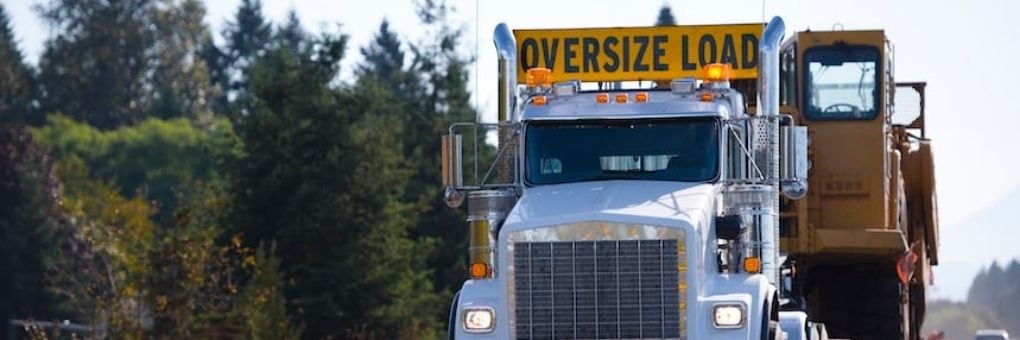Demonstrating Good Emotional Intelligence with Road Signs
Over the last couple of weeks, we’ve talked about emotional intelligence and its parallels with driving. First, we talked about demonstrating good emotional intelligence by turning on your headlights when your windshield wipers are on. During rainy or stressful times, we need to be aware of all the things around us, and alert others of the conditions, by turning on our headlights. Then we talked about demonstrating good emotional intelligence by turning down the radio. When moments arise that require extra focus and concentration, we set ourselves up for success by turning down the noise around us, and the “noise” in our heads.
This week, we want to explore how to demonstrate good emotional intelligence by following the analogy of road signs. Just as signs along the road can indicate conditions ahead, we can use signs in our interpersonal interactions to do the same. So much of our interpersonal interactions are built on interpreting other people’s actions and words. I believe we could do a better job at managing our relationships, if we are also able to interpret road signs.
Let me pause here to clarify. These road signs should not be used as an excuse for bad behavior, rather they should be used as an input into our interpretations of our interactions. Carrying around a “Grumpy-ness Ahead” sign does not permit us to be grumpy and unreasonable. But it might help others better interpret any moody or curt behavior. I believe if we can do a little more to give others around us a clue as to where we’re coming from, then our interactions will be better. With that in mind, here a couple of signs we could carry.
1. “Oversized Load”
 We tend to see this sign on trucks that are carrying more than really fits on their bed. These signs are used to alert drivers that the truck might take up more than their usual share of the lane, and we should give them plenty of space on the road. What if we, especially in the workplace, carried oversized load signs? These signs could be used to alert those around us that we have a lot going on and we might need a little extra space or grace.
We tend to see this sign on trucks that are carrying more than really fits on their bed. These signs are used to alert drivers that the truck might take up more than their usual share of the lane, and we should give them plenty of space on the road. What if we, especially in the workplace, carried oversized load signs? These signs could be used to alert those around us that we have a lot going on and we might need a little extra space or grace.
If you’re feeling like your workload or stress load is oversized, try words like ‘I am not primed to be my best right now because I am currently carrying more work than I am comfortable with. My work load feels oversized, and that is causing me to slow down on other things or it’s causing others to have to go around me on certain things. It’s causing me to be a little off-balance, and I’m approaching things with extreme caution’. Try out these words in your own head first to see which ones are true, and then pick the right ones to apply in conversations with others.
If you’re watching out for the signs others might be showing of overload, try looking out for folks who are talking about “peak seasons” or “bursts of work”. Look out for folks who are saying things like “I can’t wait until this busy season or tough project is over”. I even heard a group last week saying, “It will all be better on November 16.” These words might be an indication from others that they’re carrying an oversized load and we should give them a little extra space.
2. “Follow Me”
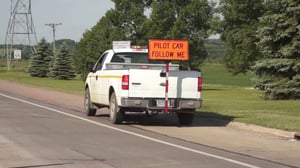 As we come to the end of a long road construction season, this sign might be all too familiar to some. When the road has been narrowed to one lane of traffic, a pilot car is responsible for leading cars through the construction. This car is marked with an orange ‘Follow Me’ sign.
As we come to the end of a long road construction season, this sign might be all too familiar to some. When the road has been narrowed to one lane of traffic, a pilot car is responsible for leading cars through the construction. This car is marked with an orange ‘Follow Me’ sign.
With so much happening in the construction zone, this sign helps make it very clear to the drivers which car they should be following and which direction they should be traveling. While sitting in construction traffic, not one of us hems and haws over if we should follow the pilot car. We don’t know anything about the pilot car driver, but the sign gives them a certain position of authority, so we follow them without question. Wouldn’t it be nice if we could put a ‘follow me’ sign on our backs and get others to follow us when we are confident we know a solid path forward?
If you’re wishing you could carry a ‘follow me’ sign, especially in moments of large decisions or heavy discussions, when we feel we have the interest of the group at heart, and the knowledge to lead, try words like “there is a path ahead that is in alignment with our organizational strategy and that minimizes some significant risk, may I show you what I’m thinking? Can we give it a try for the next few days, and see how it plays out? I’ve already vetted it with so-and-so, and I’m confident this path protects us from some of the biggest obstacles.”
If you’re watching out for someone else’s “follow me” sign, try watching specifically for those who have historically moved faster than the rest of us – those who reach conclusions quicker than others, and those who have a pattern of having to wait for us to catch up to the realities they’ve already discovered. Try asking them if they already see a path over the next hurdle and how you can help by following them and trusting them in this moment.
3. “No Passing Zone”
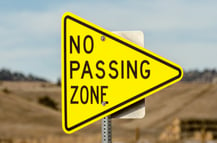 We tend to see these signs on two-lane highways, in the spots where it would not be safe for one lane of traffic to pull into the other to pass a slower vehicle. These yellow triangular signs alert us that, no matter how frustrated we may be with the slow car in front of us, it’s really not safe to try and pass them here, often because we aren’t able to fully see what is coming at us in the other lane. What could a “No Passing Zone” sign do for us in our relationships?
We tend to see these signs on two-lane highways, in the spots where it would not be safe for one lane of traffic to pull into the other to pass a slower vehicle. These yellow triangular signs alert us that, no matter how frustrated we may be with the slow car in front of us, it’s really not safe to try and pass them here, often because we aren’t able to fully see what is coming at us in the other lane. What could a “No Passing Zone” sign do for us in our relationships?
If you wish you could put a “no passing zone” sign up for your own peace of mind, try words like “At this moment, I need a little more time to think about this and make sure I understand what is going on. I need to make sure I can see the road and our direction clearly, and that I understand the obstacles. While I’m doing that, please don’t jump on ahead to the next step. Let me get caught up.
If you’re watching out for someone else’s indication that they need us not to pass them by, we can keep a cautious eye out for those who might be having trouble getting their mind around what’s going on, and barreling past them could lose them, their commitment, and their relationship altogether. Listen for words like “hang on, I’m not sure I understand” or “this is all happening so fast,” or “tell me again what you’re thinking.” Then slow down, connect with that person, and help bring them along, without sailing past them.
4. “Deer Crossing”
 These signs are an indication that deer, (or geese, elk, caribou, or reindeer in other parts of the world) often spotted on and around the roadway. If we are focused only on the road in front of you, there’s a chance this wildlife might appear from the side, seemingly out of nowhere. This peripheral movement could cause us to veer off the road, it could cause an accident, or it could, more innocently, allow us to miss a spectacular showing of nature. These kinds of encounters can feel familiar in our relationships as well. How could a “Deer Crossing” sign help us?
These signs are an indication that deer, (or geese, elk, caribou, or reindeer in other parts of the world) often spotted on and around the roadway. If we are focused only on the road in front of you, there’s a chance this wildlife might appear from the side, seemingly out of nowhere. This peripheral movement could cause us to veer off the road, it could cause an accident, or it could, more innocently, allow us to miss a spectacular showing of nature. These kinds of encounters can feel familiar in our relationships as well. How could a “Deer Crossing” sign help us?
If you’re thinking you might need a “Deer Crossing” sign, it might be because you’re having one of those days where the stuff that’s going on at home is going to jump in front of the car at any moment. It is going to prevent you from being your best self in your interactions. Worse yet, your distraction may cause drama, uncertainty, or hostility from outside of work to carry itself into your workplace. Many of us prefer to keep work and life separate, and not talk much about the things going on at home while we’re at work, and that’s okay – there’s no need to air all of our laundry at the office. But maybe, just maybe, we can try a phrase like, “I’ll admit my mind isn’t fully in the game today, I’ve got some other things on my mind.” Say those words to yourself and figure out how you can compartmentalize, even for an hour or two, to focus on work. If you still can’t, try saying, to someone you trust, “I’m not sure I’m primed to make excellent decisions today because I’m a little distracted, can you help me keep an eye out for things I might me missing today?”
If you’re watching for someone else’s “Deer Crossing” sign, it’s important to remember that feelings – good or bad – are real and totally acceptable, and that they can also be a distraction. Watch, for example, for someone who is super excited about something, perhaps the vacation of a lifetime, a new house, or a new baby. Listen for their stories of focus on something outside of work and hear those as an indication that they may be so focused on that other thing that they’re missing things in the periphery at work. Be a friend and keep an eye out for obstacles, hurdles, potential potholes, and other risks you can help protect them from
5. “Soft Shoulder”
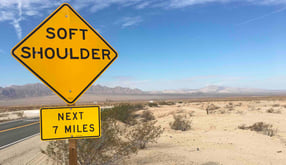 These signs might not be as familiar to you. These signs are used to indicate when the shoulder of the road is not safe to pull on to. It could mean the ground on the shoulder is not as stable as it usually is, possibly because of construction or heavy rainfall. It may mean that your vehicle may have less traction when pulling on to the shoulder and you should use extra caution. As with most road signs, it’s an admonition to be extra cautious at that moment because otherwise normal behavior might cause an accident in this zone. What could a “Soft Shoulder” sign do to for our relationships with those around us?
These signs might not be as familiar to you. These signs are used to indicate when the shoulder of the road is not safe to pull on to. It could mean the ground on the shoulder is not as stable as it usually is, possibly because of construction or heavy rainfall. It may mean that your vehicle may have less traction when pulling on to the shoulder and you should use extra caution. As with most road signs, it’s an admonition to be extra cautious at that moment because otherwise normal behavior might cause an accident in this zone. What could a “Soft Shoulder” sign do to for our relationships with those around us?
If you’re thinking you might need to carry a “Soft Shoulder” sign, it might be because you’re thinking something like this, ‘Usually you are welcome to come to me with anything. I can be the shoulder to cry on, I can be the one that you lean on, I will listen to your vents and complaints, but right now, I am at my wit’s end, and I’m candidly not as patient listening to you as I usually would be. So if you complain about something that I’ve heard before, I might push back and tell you to do something about it instead of whining. If you start crying or venting in an angry way, my emotions might get the better of me, and I may not respond particularly well. Right now, my shoulder is not as stable as usual. It’s a soft shoulder, go easy on me” Perhaps those words aren’t the ones you’d use, but giving verbal cues to the other person such as “I’m so sorry, now is not a great time, can we connect on this tomorrow?” or “I’m so grateful you trust me with this kind of thing, and I want to give you the focused attention you deserve, can it wait until tomorrow?” or something else along those lines would give the other person a cue that your shoulder isn’t quite as soft as it usually is.
If you’re keeping an eye out for someone else’s “soft shoulder” sign, you might try thinking through your last couple of interactions with them – have you been whining or venting more than usual? Is now a time to give that listener a break from that? Listen carefully to any cues they give you about “now’s not a good time, or “can you come back later”, or “have you tried xyz?” If you see them catching their breath, composing themselves, quickly catching an inadvertent eye-roll, you may have some cues on your hand that their shoulder isn’t as soft today as it has sometimes been – it may be a better choice to take some action to solve the problem on your own or bring a more positive spin to the conversation and give their shoulder time to get back to its usual strength.
6. “Yield”
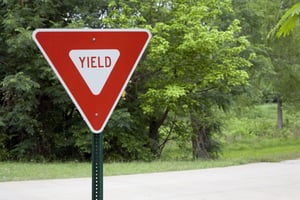 At the risk of pushing the analogy too far, I’ll offer one last road sign for us to consider in our interpersonal interactions. This one is not a reminder for what other people should do, it’s pointed right as us, telling us as the driver of the vehicle to yield the right of way to the other cars on the road. It means look, really look, to see if someone else is coming. If there’s no one else, then proceed with caution. If there is someone else, let them go first. How might this be true for our interactions with others?
At the risk of pushing the analogy too far, I’ll offer one last road sign for us to consider in our interpersonal interactions. This one is not a reminder for what other people should do, it’s pointed right as us, telling us as the driver of the vehicle to yield the right of way to the other cars on the road. It means look, really look, to see if someone else is coming. If there’s no one else, then proceed with caution. If there is someone else, let them go first. How might this be true for our interactions with others?
If you need a “yield” sign in your planner to remind you to listen, really listen, to see if someone else is trying to take the conversation in a new direction, or to offer ideas that are in the best interest of the business, try this. I might tell myself something like this: “If no one else is speaking up, then I can proceed with my idea or suggestion with caution. If there is someone else, then I should let them go first.” In the context of relationship building within organizations, I may need to yield the floor to someone else so they can shine or yield the “good seat” to someone else so they can enjoy the view.
If you’re coaching someone else who may need to have their own “yield” sign from time to time, try sharing with them the usefulness of listening before you speak, of letting others go first, or of yielding to the other person who has an idea every bit as un-tested as your own. Offer them a tool or perhaps a guideline they can hang on to that makes it less tempting to talk first, and instead give that time to others. “Listen to understand, rather than reply” is a phrase that sometimes helps here. “Count to 10 before you speak, to give others a chance to jump in” is another useful way to yield the conversation to others. If that person is a leader, appeal to how they can follow servant leadership principles and yield to the other person so that person has a chance to grow.
There you have it. Six road signs to help us with interpersonal connections. For years, communication experts have extolled the virtues of word pictures. Maybe you can’t carry an actual sign, but in any of these circumstances, you might be able to describe the sign you wish you could carry to give others insight into your present state of mind. Likewise, you can use the same word pictures to inquire about the state of mind of those you’re working with. We believe that together, with a little compassion, and a fair amount of communication, we can help co-create better, safer work zones for all of us!

